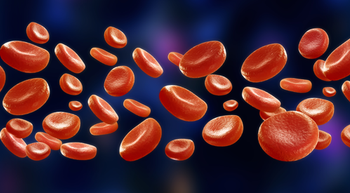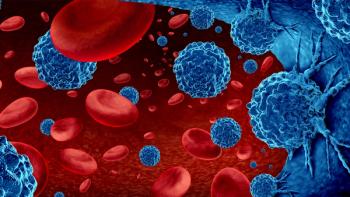As oncology management continues to become more complex, the importance of multidisciplinary management, particularly of rare tumors, by a specialized multidisciplinary team is even more paramount.
Ewing sarcoma is a highly aggressive bone and soft tissue cancer that is the second most common primary bone tumor for patients younger than 18 years.1 Approximately 50% of the Ewing sarcoma family of tumors occur in adolescent and young adults (AYAs), representing only 5% of all malignant diagnoses in the AYA population.2 This rare disease behaves aggressively, with a survival rate of approximately 75% for localized sarcoma and a 5-year survival rate of 20% to 30% for metastatic disease.1,3
Sarcoma, a specialty disease, requires multidisciplinary expertise to ensure the best outcome and to provide an aggressive, tailored treatment plan with a multimodality therapy consisting of chemotherapy, surgery, and radiation. The role of the oncology advanced practice provider (APP) is multidimensional and dynamic, as they provide not only direct standard oncologic medical care but also emotional support and advocacy for patients and their families.
First-line treatment for Ewing sarcoma consists of an alternating multidrug therapy of vincristine, doxorubicin, and cyclophosphamide, alternating with ifosfamide and etoposide (VDC/IE) in an intense dose-dense approach every 2 weeks. Chemotherapy is implemented in an interdigitated manner, with definitive treatment to the primary site that consists of surgical resection and/or radiation therapy that is determined on a case-by-case basis. In a clinical trial, patients with localized disease who had the best survival outcomes completed 14 days of dose-dense therapy with minimal delays of chemotherapy.3
Patient Case
A 30-year-old Ashkenazi Jewish man with a history of well-controlled ulcerative proctitis presented to a local community hospital emergency department with 3 weeks of progressively worsening severe back pain radiating to his bilateral feet. MRI imaging revealed a T11-level lobulated heterogeneously enhancing mass in the soft tissue in the left paraspinal region extending into the left posterior epidural space, measuring 3 cm in size. There was evidence of cord compression, with the mass displacing the conus medullaris anteriorly and potential mild edema involving the conus medullaris at T12. He was taken to the operating room and underwent a T11 laminectomy with resection of the epidural mass. The pathology eventually revealed an undifferentiated malignant small round blue cell tumor consistent with Ewing sarcoma. Immunohistochemistry was positive for CD99 and FLI1, and it was negative for GFAP, S100, CD34, CD45, OCT4, myogenin, TLE1, chromogranin A, and CD56. Synaptophysin and vimentin were focally positive.
Chemotherapy is highly toxic, with potential for significant complications such as cardiotoxicity, neutropenic fever, hemorrhagic cystitis, nephrotoxicity, infertility, and sepsis. In such a situation, multidisciplinary care involving not only multispecialty physician care but also all multilevel care, including nurses, social workers, and APPs, is critical to survival outcomes. Identifying potential complications for early intervention and optimally maintaining the well-being of patients is crucial to positive patient outcomes and quality of life.
This case report highlights the importance of multidisciplinary management in providing complex oncology care in AYAs with Ewing sarcoma.
The patient was discharged to neuro-oncology outpatient consultation for what was thought to be (initially, at time of discharge) an ependymoma. At the time of outpatient consultation, the patient and his family were informed of the cancer diagnosis. As one can imagine, this dramatic change in diagnosis was overwhelming for the patient and his family.
Care was immediately transferred to our sarcoma team, which led to a discussion of the intensity of the treatment plan and the additional workup recommended, including a staging PET/CT scan to determine whether the cancer had spread.
A PET/CT was performed that noted hypermetabolism within the left posterior T11 vertebral body, pedicle, and transverse process; T10 spinous process and T10/T11 neural foramen; and surgical bed spanning from T10 to T12, compatible with residual primary tumor.
Furthermore, bilateral pulmonary nodules were noted as consistent with metastatic disease, with the largest nodule in the left lower lobe measuring 10 mm that had increased in size from 6 mm.
The original pathology specimen was sent for fluorescence in situ hybridization assay confirming EWSR1 gene rearrangement, further supporting the Ewing sarcoma diagnosis.
He was then started on first-line therapy with dose-dense VDC/IE, with plans to complete 14 cycles of dose-compressed therapy. The patient did experience complications consisting of cytopenias requiring blood transfusions or slight delays in treatment, a hypotensive episode requiring a rapid response, an anal fissure that resolved with diltiazem hydrochloride 2% topical ointment, and anxiety. He had minimal delays in therapy, nearly always receiving treatment within a 17-day window. Restaging imaging after 4 cycles of chemotherapy confirmed responsive disease in the spine and stable lung nodules.
Several multidisciplinary discussions took place with surgery and radiation oncology to determine the best course of management for definitive treatment of the initial residual bone and soft tissue disease. Ultimately, primary radiation therapy and whole-lung radiation were recommended. He then proceeded with concurrent chemoradiation therapy to T11 and T12 vertebral bodies and paraspinal muscles receiving 50 Gy via intensity-modulated radiation therapy. After completion of 14 cycles of therapy, a chest CT noted resolution of the lung nodules. He then received whole-lung irradiation, completing 15 Gy in 10 fractions.
During treatment, he also underwent genetic counseling and testing. Fortunately, no deleterious mutations for hereditary cancers were found. Only 2 variants of uncertain significance were identified: MSH2 and XRCC2. These variants were not considered clinically actionable at this time.
After whole-lung irradiation, he converted to surveillance for 5 years. During surveillance, 4 years after completion of therapy, MRI imaging showed changes concerning possible recurrence, with slight increased conspicuity of the T11 lesion with a slight increase in surrounding ill-defined enhancement and edema. As anticipated, this created a significant amount of anxiety for the patient.
Fortunately, after PET evaluation, it was confirmed that there was no abnormal hypermetabolic activity and the changes were consistent with postradiation effects. He has since completed his 5 years of routine surveillance as of January 2024, and the patient remains on annual clinical surveillance, free of disease.
Throughout the patient’s treatment, he had immense social support from his family and our AYA social worker, along with emotional encouragement from the whole care team. As the primary oncology APP, there is a high level of responsibility in focusing on direct patient care with adverse effect management, patient care coordination, and emotional support. Oncology physician assistants (PAs) have been proven to help improve organizational efficiency and enhancement in the delivery of health care, as demonstrated by the descriptive study performed by The University of Texas MD Anderson Cancer Center team.4 Oncology APPs not only provide direct patient care, but they also play a vital role in communicating with patients and their families.
Throughout this patient’s care, additional specialty APPs were also directly involved in overseeing his chemotherapy and any complications. To this day, providing reassurance and encouragement throughout this patient’s journey, even during surveillance, has been paramount in his overall well-being and mental health.
Key Insights
A cancer diagnosis at such a critical time in a young adult’s life is devastating and highly disruptive. AYAs, whose age ranges from 15 to 39 years, are at a vulnerable stage in their lives, facing unique challenges. They are anticipating more independence that is now completely upended. They may be in high school, college, or have graduated from college and are starting their careers. Some are starting or are currently in committed relationships and are considering starting a family of their own. To also have to face the threat of infertility from the required lifesaving therapy adds another layer of psychological distress that takes an emotional toll.
AYA cancer survivors have demonstrated a higher risk of mental health issues. Surprisingly, “levels of AYA psychological distress do not appear to correlate with the severity of the cancer diagnosis.”5
Taking into account the psychological impacts of the treatment, these patients require ongoing encouragement and support well beyond their initial treatment that extends into their survivorship. This case demonstrates the pivotal role of a cohesive multidisciplinary team in navigating the complex care of oncology patients from diagnosis, treatment, and posttreatment surveillance.
APPs particularly play a multifaceted role in providing direct medical care, as well as essential emotional support and advocacy for patients and their families. Multidisciplinary care can lead to successful management and positive outcomes, even in the face of such a complex and aggressive oncologic diagnosis.
Acknowledgements to the patient and our primary oncology team James S. Hu, MD; Lee J. Helman, MD; Omar M. Ragab, MD; Jan Huynh, LCSW; Breidi Calloway, NP; Angelita Ramirez, LVN; Carmen Martinez, LVN; and Jennifer Oloteo, MA, and recognizing all our Norris Comprehensive Cancer Center and Hospital team members and the USC Adolescent Young Adult program who participated in this patient’s care.
References
- Cotterill SJ, Ahrens S, Paulussen M, et al. Prognostic factors in Ewing’s tumor of bone: analysis of 975 patients from the European Intergroup Cooperative Ewing’s Sarcoma Study Group. J Clin Oncol. 2000;18(17):3108-3114. doi:10.1200/JCO.2000.18.17.3108
- Herzog CE. Overview of sarcomas in the adolescent and young adult population. J Pediatr Hematol Oncol. 2005;27(4):215-218. doi:10.1097/01.mph.0000161762.53175.e4
- Womer RB, West DC, Krailo MD, et al. Randomized controlled trial of interval-compressed chemotherapy for the treatment of localized Ewing sarcoma: a report from the Children’s Oncology Group. J Clin Oncol. 2012;30(33):4148-4154. doi:10.1200/JCO.2011.41.5703
- Ross AC, Polansky MN, Parker PA, Palmer JL. Understanding the role of physician assistants in oncology. J Oncol Pract. 2010;6(1):26-30. doi:10.1200/JOP.091062
- Patterson P, McDonald FE, Zebrack B, Medlow S. Emerging issues among adolescent and young adult cancer survivors. Semin Oncol Nurs. 2015;31(1):53-59. doi:10.1016/j.soncn.2014.11.006



















































































